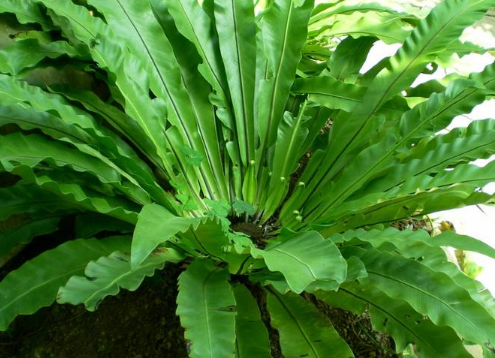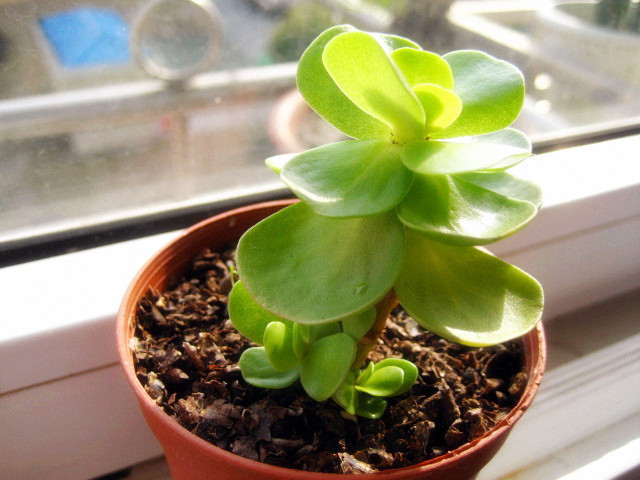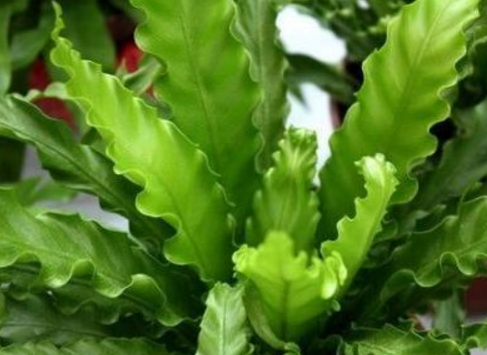The culture method of bird's nest fern
1. Temperature
The suitable temperature for the growth of bird's nest fern is 22-27 ℃. It is not resistant to high temperature or cold, and can not be lower than 5 ℃ in winter. Too low temperature can easily cause the leaf margin to turn brown, and even cause plant death by frostbite.

two。 Light
Bird's nest fern is a negative herb, the demand for light is not very large, an appropriate amount of scattered light can maintain its normal growth, to stay away from strong light, and potted plants can be kept in bright indoor light for maintenance.
3. Soil
Bird nest ferns can be made of rotten leaf soil or peat soil, vermiculite and a small amount of river sand, or mixed with fern roots, broken bark, moss or broken brick grains mixed with a small amount of humic soil. A small amount of crushed lime can be added to the basin every spring, which is more conducive to plant growth.
4. Moisture content
Bird's nest ferns grow rapidly in summer, so it is time to water more to keep the air humid. And watering should also pay attention to watering thoroughly, because the leaves will be more and more dense, watering thoroughly can prevent the leaves from drying up and becoming curly.
The culture method of bird's nest fern
Bird's nest fern can be sown and propagated by spores. Spore propagation has been widely used as a commercial batch production. Generally available ramet propagation. When the plant grows larger, there will often be small branches, which can be cut off slowly with a sharp knife before the new buds are born in late spring and early summer, and then planted separately. In addition, what are the matters needing attention when breeding?
The soil of potted bird nest fern is the best in peat soil or rotten leaf soil. The growth depends on planting nest fern for 2-3 years, the plant shape is open, and the root is full of pot rack, which can be protruded from the basin, remove part of the residual root and the base withered sporophyte, take out the seed plant, and replant it on the pot respectively. When changing the basin in spring, rotten leaf soil and moss should be added to the basin, and a little gravel should be added.
The suitable temperature for the growth of bird's nest fern is 22-27 ℃. It should be shaded in summer or placed in a sparse shade place under a big tree to avoid strong direct sunlight, which is beneficial to growth and make the leaves shiny. Put it in a brightly lit place indoors, not in the dark for a long time. It should be moved into the greenhouse in winter and the temperature should be kept above 16 ℃ so that it can continue to grow, but the lowest temperature should not be lower than 5 ℃.
Under the condition of high temperature and humidity in summer, the vigorous growth of new leaves needs more water spraying, fully spraying the leaf surface and maintaining a higher air temperature, which is beneficial to spore germination. With the increase of the leaves, the leaves are often covered with the culture soil in the basin, and the pot must be watered thoroughly in order to avoid the dry and curl of the leaves caused by the lack of water.
The culture method of bird's nest fern
Bird's nest fern is a perennial evergreen epiphytic herb of Pteridaceae. Tropical and subtropical land
It is distributed in Hainan, Taiwan, Yunnan and other places in China.
There are many varieties and varieties of bird's nest fern, the common ones are wrinkled bird's nest fern and sawtooth bird's nest fern.
And round-leaf bird's nest fern.
The morphological characteristic plant is funnel-shaped or bird's nest-shaped, and the plant height is 50mm 12001! Clumps on the trunks or rocks of a tropical rain forest. The leaf is broadly lanceolate, the leaf margin is wavy wrinkled or serrated, the adult leaf is about 100cm long and wide 8~15cm, clustered at the top of the short rhizome, the front and back are bright green and shiny. There are sporangium groups on both sides of the veins on the back of the leaves. The lobes on the rhizome have long beard hairs.
The growth habit likes the environment of high temperature, humidity and shade, and the suitable temperature is 20 ~ 271. Not cold-resistant, not less than 51 in winter. The cultivation medium should not use ordinary soil, but should be made of fine snake sawdust or coconut shell powder, bark, peat soil, moss or broken bricks. Nature often grows on tree trunks and rocks.
Propagation methods are commonly used in ramet or cutting propagation. The former can be carried out in spring and summer. The latter cut the adult leaves of bird's nest fern from top to bottom in late spring, cut them longitudinally to 4 with a sharp knife, and then split them into plants. the cultivation medium should not be too wet and should be maintained by conventional methods after the new leaves grew, otherwise it would easily lead to decay.
The cultivation and maintenance of bird's nest fern is often used to form a cultivation substrate with good drainage, massive bark rich in humus, brick grains, serpent sawdust, peat soil, moss and so on. Usually, the root is covered with moss, then a coarse-grained matrix is placed at the bottom of the basin, and then the plants are planted with fine soil. In addition to potted plants, the form of cultivation can also be used for wall-hanging cultivation, commonly used snake wood plates, or palm cross-section blocks, open a kind of planting hole below its center, put the bird's nest fern whose roots are covered with moss into the planting hole, and then fill the compacted cultivation matrix around the rhizosphere, which is interspersed with wire to be fixed, and watered with permeable water to place the wet place to strengthen maintenance. Do you know the tortoise carrying bamboo?
The cultivation site of bird's nest fern should be shady and humid, with sunshine of about 4 cm in summer and 6 cm in spring and autumn. It is necessary to sprinkle water frequently during the growing period, especially the higher the air humidity is, the more conducive to growth. When organic liquid fertilizer is applied once a month, 0.3% can be sprayed on the leaf surface.
5 ^ potassium dihydrogen phosphate can keep the leaf color bright green. Winter should be warm and sheltered from the wind.
For horticultural use, the leaves of bird's nest fern are green and bright, and their shape is beautiful and chic. It is a kind of excellent and beautiful large and medium-sized indoor foliage plants. Often hanging from high places indoors or hanging on the wall, also
Small pots are often planted for living room and conference room layout. Its leaves are an excellent match for flower arrangement.
- Prev

The cause of yellowing and softening of leaves
The sun shines on a hot summer day, the sun shines directly, the soil moisture is missing, and the direct sunlight causes the tender leaves to be burned, and then the phenomenon of yellowing and softening occurs. Prevention and control measures: do not let the money wood suddenly accept the sun exposure, can give appropriate light
- Next

What about the withered and yellow leaves of the bird's nest fern?
1. The temperature ensures that the normal growth temperature of the plant is about 22-27 ℃, the lowest can not be less than 5 ℃, otherwise the leaves will be frostbitten, become scorched and the plant will wither. two。 Humidity in order to prevent leaves from yellowing and drying up, we should often spray water on the leaves, keep them clean, and spray water around to keep the environment moist.
Related
- Fuxing push coffee new agricultural production and marketing class: lack of small-scale processing plants
- Jujube rice field leisure farm deep ploughing Yilan for five years to create a space for organic food and play
- Nongyu Farm-A trial of organic papaya for brave women with advanced technology
- Four points for attention in the prevention and control of diseases and insect pests of edible fungi
- How to add nutrient solution to Edible Fungi
- Is there any good way to control edible fungus mites?
- Open Inoculation Technology of Edible Fungi
- Is there any clever way to use fertilizer for edible fungus in winter?
- What agents are used to kill the pathogens of edible fungi in the mushroom shed?
- Rapid drying of Edible Fungi

